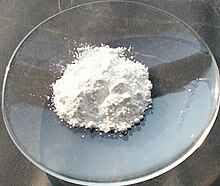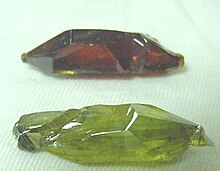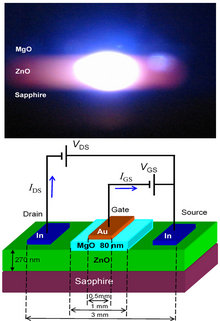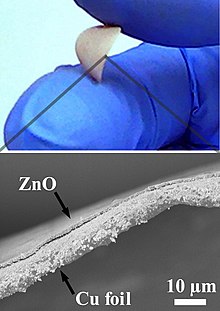Zinc oxide

| |
| Names | |
|---|---|
| Other names
Zinc white, calamine, philosopher's wool, Chinese white, flowers of zinc
| |
| Identifiers | |
3D model (
JSmol ) |
|
| ChEBI | |
| ChEMBL | |
| ChemSpider | |
| DrugBank | |
ECHA InfoCard
|
100.013.839 |
| EC Number |
|
| 13738 | |
| KEGG | |
PubChem CID
|
|
RTECS number
|
|
| UNII | |
| UN number | 3077 |
CompTox Dashboard (EPA)
|
|
| |
| |
| Properties | |
| ZnO | |
| Molar mass | 81.406 g/mol[1] |
| Appearance | White solid[1] |
| Odor | Odorless |
| Density | 5.6 g/cm3[1] |
| Melting point | 1,974 °C (3,585 °F; 2,247 K) (decomposes)[1][7] |
| Boiling point | 2,360 °C (4,280 °F; 2,630 K) (decomposes) |
| 0.0004% (17.8°C)[2] | |
| Band gap | 3.2 eV (direct)[3] |
| Electron mobility | 180 cm2/(V·s)[3] |
| −27.2·10−6 cm3/mol[4] | |
Thermal conductivity
|
0.6 W/(cm·K)[5] |
Refractive index (nD)
|
n1=2.013, n2=2.029[6] |
| Structure[8] | |
Wurtzite
| |
| C6v4-P63mc | |
a = 3.2495 Å, c = 5.2069 Å
| |
Formula units (Z)
|
2 |
| Tetrahedral | |
| Thermochemistry[9] | |
Heat capacity (C)
|
40.3 J·K−1mol−1 |
Std molar
entropy (S⦵298) |
43.65±0.40 J·K−1mol−1 |
Std enthalpy of (ΔfH⦵298)formation |
-350.46±0.27 kJ mol−1 |
Gibbs free energy (ΔfG⦵)
|
-320.5 kJ mol−1 |
Enthalpy of fusion (ΔfH⦵fus)
|
70 kJ/mol |
| Pharmacology | |
| QA07XA91 (WHO) | |
| Hazards | |
| GHS labelling: | |

| |
| Warning | |
| H400, H401 | |
| P273, P391, P501 | |
| NFPA 704 (fire diamond) | |
| Flash point | 1,436 °C (2,617 °F; 1,709 K) |
| Lethal dose or concentration (LD, LC): | |
LD50 (median dose)
|
240 mg/kg (intraperitoneal, rat)[10] 7950 mg/kg (rat, oral)[11] |
LC50 (median concentration)
|
2500 mg/m3 (mouse)[11] |
LCLo (lowest published)
|
2500 mg/m3 (guinea pig, 3–4 h)[11] |
| NIOSH (US health exposure limits): | |
PEL (Permissible)
|
TWA 5 mg/m3 (fume) TWA 15 mg/m3 (total dust) TWA 5 mg/m3 (resp dust)[2] |
REL (Recommended)
|
Dust: TWA 5 mg/m3 C 15 mg/m3 Fume: TWA 5 mg/m3 ST 10 mg/m3[2] |
IDLH (Immediate danger) |
500 mg/m3[2] |
| Safety data sheet (SDS) | ICSC 0208 |
| Related compounds | |
Other anions
|
Zinc sulfide Zinc selenide Zinc telluride |
Other cations
|
Cadmium oxide Mercury(II) oxide |
Except where otherwise noted, data are given for materials in their standard state (at 25 °C [77 °F], 100 kPa).
| |
Zinc oxide is an
History
Early humans probably used zinc compounds in processed
The Romans produced considerable quantities of
From the 12th to the 16th century zinc and zinc oxide were recognized and produced in India using a primitive form of the direct synthesis process. From India, zinc manufacturing moved to China in the 17th century. In 1743, the first European zinc smelter was established in Bristol, United Kingdom.[21] Around 1782 Louis-Bernard Guyton de Morveau proposed replacing lead white pigment with zinc oxide.[22]
The main usage of zinc oxide (zinc white) was in paints and as an additive to ointments. Zinc white was accepted as a pigment in oil paintings by 1834 but it did not mix well with oil. This problem was solved by optimizing the synthesis of ZnO. In 1845, Edme-Jean Leclaire in Paris was producing the oil paint on a large scale, and by 1850, zinc white was being manufactured throughout Europe. The success of zinc white paint was due to its advantages over the traditional white lead: zinc white is essentially permanent in sunlight, it is not blackened by sulfur-bearing air, it is non-toxic and more economical. Because zinc white is so "clean" it is valuable for making tints with other colors, but it makes a rather brittle dry film when unmixed with other colors. For example, during the late 1890s and early 1900s, some artists used zinc white as a ground for their oil paintings. All those paintings developed cracks over the years.[23]
In recent times, most zinc oxide has been used in the
Chemical properties
Pure ZnO is a white powder, but in nature it occurs as the rare mineral zincite, which usually contains manganese and other impurities that confer a yellow to red color.[25]
Crystalline zinc oxide is
Zinc oxide is an
- ZnO + 2 HCl → ZnCl2 + H2O
Solid zinc oxide will also dissolve in alkalis to give soluble zincates:
- ZnO + 2 NaOH + H2O → Na2[Zn(OH)4]
ZnO reacts slowly with fatty acids in oils to produce the corresponding

ZnO also forms cement-like material when treated with phosphoric acid; related materials are used in dentistry.[29] A major component of zinc phosphate cement produced by this reaction is hopeite, Zn3(PO4)2·4H2O.[30]
ZnO decomposes into zinc vapor and oxygen at around 1975 °C with a standard oxygen pressure. In a carbothermic reaction, heating with carbon converts the oxide into zinc vapor at a much lower temperature (around 950 °C).[27]
- ZnO + C → Zn(Vapor) + CO
Physical properties


Structure
Zinc oxide crystallizes in two main
Hexagonal and zincblende polymorphs have no inversion symmetry (reflection of a crystal relative to any given point does not transform it into itself). This and other lattice symmetry properties result in piezoelectricity of the hexagonal and zincblende ZnO, and pyroelectricity of hexagonal ZnO.
The hexagonal structure has a point group 6 mm (
Mechanical properties
ZnO is a wide-band gap semiconductor of the
ZnO is a relatively soft material with approximate hardness of 4.5 on the
Among the tetrahedrally bonded semiconductors, it has been stated that ZnO has the highest piezoelectric tensor, or at least one comparable to that of
Electrical and optical properties
Favourable properties of zinc oxide include good transparency, high
ZnO has a relatively wide
Most ZnO has
Reliable
Current limitations to p-doping limit electronic and optoelectronic applications of ZnO, which usually require junctions of n-type and p-type material. Known p-type dopants include group-I elements Li, Na, K; group-V elements N, P and As; as well as copper and silver. However, many of these form deep acceptors and do not produce significant p-type conduction at room temperature.[13]
Electron mobility of ZnO strongly varies with temperature and has a maximum of ~2000 cm2/(V·s) at 80 K.[43] Data on hole mobility are scarce with values in the range 5–30 cm2/(V·s).[44]
ZnO discs, acting as a
Zinc oxide is noted for its strongly
Production
For industrial use, ZnO is produced at levels of 105 tons per year[25] by three main processes:[24]
Indirect process
In the indirect or French process, metallic zinc is melted in a graphite crucible and vaporized at temperatures above 907 °C (typically around 1000 °C). Zinc vapor reacts with the oxygen in the air to give ZnO, accompanied by a drop in its temperature and bright luminescence. Zinc oxide particles are transported into a cooling duct and collected in a bag house. This indirect method was popularized by Edme Jean LeClaire of Paris in 1844 and therefore is commonly known as the French process. Its product normally consists of agglomerated zinc oxide particles with an average size of 0.1 to a few micrometers. By weight, most of the world's zinc oxide is manufactured via French process.
Direct process
The direct or American process starts with diverse contaminated zinc composites, such as
Wet chemical process
A small amount of industrial production involves wet chemical processes, which start with aqueous solutions of zinc salts, from which zinc carbonate or zinc hydroxide is precipitated. The solid precipitate is then calcined at temperatures around 800 °C.
Laboratory synthesis

Numerous specialised methods exist for producing ZnO for scientific studies and niche applications. These methods can be classified by the resulting ZnO form (bulk, thin film, nanowire), temperature ("low", that is close to room temperature or "high", that is T ~ 1000 °C), process type (vapor deposition or growth from solution) and other parameters.
Large single crystals (many cubic centimeters) can be grown by the gas transport (vapor-phase deposition),
Ordinary white powdered zinc oxide can be produced in the laboratory by electrolyzing a solution of sodium bicarbonate with a zinc anode. Zinc hydroxide and hydrogen gas are produced. The zinc hydroxide upon heating decomposes to zinc oxide:
- Zn + 2 H2O → Zn(OH)2 + H2
- Zn(OH)2 → ZnO + H2O
ZnO nanostructures
Nanostructures of ZnO can be synthesized into a variety of morphologies including nanowires,
Aligned ZnO nanowires on pre-seeded
Applications
The applications of zinc oxide powder are numerous, and the principal ones are summarized below. Most applications exploit the reactivity of the oxide as a precursor to other zinc compounds. For material science applications, zinc oxide has high refractive index, high thermal conductivity, binding, antibacterial and UV-protection properties. Consequently, it is added into materials and products including plastics, ceramics, glass, cement,[60] rubber, lubricants,[12] paints, ointments, adhesive, sealants, concrete manufacturing, pigments, foods, batteries, ferrites, fire retardants, etc.[61]
Rubber industry
Between 50% and 60% of ZnO use is in the rubber industry.[62] Zinc oxide along with stearic acid is used in the sulfur vulcanization of rubber.[24][63] ZnO additives also protect rubber from fungi (see medical applications) and UV light.
Ceramic industry
Ceramic industry consumes a significant amount of zinc oxide, in particular in ceramic glaze and frit compositions. The relatively high heat capacity, thermal conductivity and high temperature stability of ZnO coupled with a comparatively low coefficient of expansion are desirable properties in the production of ceramics. ZnO affects the melting point and optical properties of the glazes, enamels, and ceramic formulations. Zinc oxide as a low expansion, secondary flux improves the elasticity of glazes by reducing the change in viscosity as a function of temperature and helps prevent crazing and shivering. By substituting ZnO for BaO and PbO, the heat capacity is decreased and the thermal conductivity is increased. Zinc in small amounts improves the development of glossy and brilliant surfaces. However, in moderate to high amounts, it produces matte and crystalline surfaces. With regard to color, zinc has a complicated influence.[62]
Medicine
Skin treatment
Zinc oxide as a mixture with about 0.5% iron(III) oxide (Fe2O3) is called calamine and is used in calamine lotion. Historically the mineral calamine is a mixture of the oxides zincite and hemimorphite.
Zinc oxide is widely used to treat a variety of skin conditions, including
It is also a component in tape (called "zinc oxide tape") used by athletes as a bandage to prevent soft tissue damage during workouts.[68]
Antibacterial
Zinc oxide is used in
Powdered zinc oxide has deodorizing and antibacterial properties.[76]ZnO is added to cotton fabric, rubber, oral care products,[77][78] and food packaging.[79][80] Enhanced antibacterial action of fine particles compared to bulk material is not exclusive to ZnO and is observed for other materials, such as silver.[81] This property results from the increased surface area of the fine particles.
Sunscreen
Zinc oxide is used in
Many sunscreens use nanoparticles of zinc oxide (along with nanoparticles of titanium dioxide) because such small particles do not scatter light and therefore do not appear white. The nanoparticles are not absorbed into the skin more than regular-sized zinc oxide particles are,[88] and are only absorbed into the outermost layer of the skin but not into the body.[88]
Dental restoration
When mixed with eugenol, zinc oxide eugenol is formed, which has applications as a restorative and prosthodontic in dentistry.[29][89]
Food additive
Zinc oxide is added to many food products, including breakfast cereals, as a source of zinc,[90] a necessary nutrient. Zinc sulfate is also used for the same purpose. Some prepackaged foods also include trace amounts of ZnO even if it is not intended as a nutrient.
Pigment
Zinc oxide (zinc white) is used as a
UV absorber
Micronized and nano-scale zinc oxide provides strong protection against
Coatings
Paints containing zinc oxide powder have long been utilized as anticorrosive coatings for metals. They are especially effective for galvanized iron. Iron is difficult to protect because its reactivity with organic coatings leads to brittleness and lack of adhesion. Zinc oxide paints retain their flexibility and adherence on such surfaces for many years.[61]
ZnO highly n-type doped with
Plastics, such as polyethylene naphthalate (PEN), can be protected by applying zinc oxide coating. The coating reduces the diffusion of oxygen through PEN.[98] Zinc oxide layers can also be used on polycarbonate in outdoor applications. The coating protects polycarbonate from solar radiation, and decreases its oxidation rate and photo-yellowing.[99]
Corrosion prevention in nuclear reactors
Zinc oxide depleted in 64Zn (the zinc isotope with atomic mass 64) is used in corrosion prevention in nuclear pressurized water reactors. The depletion is necessary, because 64Zn is transformed into radioactive 65Zn under irradiation by the reactor neutrons.[100]
Methane reforming
Zinc oxide (ZnO) is used as a pretreatment step to remove hydrogen sulfide (H2S) from natural gas following hydrogenation of any sulfur compounds prior to a methane reformer, which can poison the catalyst. At temperatures between about 230–430 °C (446–806 °F), H2S is converted to water by the following reaction:[101]
- H2S + ZnO → H2O + ZnS
Electronics


ZnO has wide
The pointed tips of ZnO nanorods result in a strong enhancement of an electric field. Therefore, they can be used as field emitters.[109]
Aluminium-doped ZnO layers are used as transparent
Transparent thin-film transistors (TTFT) can be produced with ZnO. As field-effect transistors, they do not need a p–n junction,[111] thus avoiding the p-type doping problem of ZnO. Some of the field-effect transistors even use ZnO nanorods as conducting channels.[112]
Gas sensors
Zinc oxide is used in semiconductor gas sensors for detecting airborne compounds such as hydrogen sulfide, nitrogen dioxide, and volatile organic compounds. ZnO is a semiconductor that becomes n-doped by adsorption of reducing compounds, which reduces the detected electrical resistance through the device, in a manner similar to the widely used tin oxide semiconductor gas sensors. It is formed into nanostructures such as thin films, nanoparticles, nanopillars or nanowires in order to provide large surface area for interaction with gasses. The sensors are made selective for specific gasses by doping or surface-attaching materials such as catalytic noble metals.[113][114]
Piezoelectricity
The
In 2008 the Center for Nanostructure Characterization at the

In form of a thin film ZnO has been demonstrated in miniaturised high frequency thin film resonators, sensors and filters.
Li-ion battery and supercapacitors
ZnO is a promising anode material for lithium-ion battery because it is cheap, biocompatible, and environmentally friendly. ZnO has a higher theoretical capacity (978 mAh g−1) than many other transition metal oxides such as CoO (715 mAh g−1), NiO (718 mAh g−1) and CuO (674 mAh g−1).[118] ZnO is also used as an electrode in supercapacitors.[119]
Safety
As a food additive, zinc oxide is on the U.S. FDA's list of generally recognized as safe, or GRAS, substances.[120]
Zinc oxide itself is non-toxic; it is hazardous, however, to inhale high concentrations of zinc oxide fumes, such as generated when zinc or zinc alloys are melted and oxidized at high temperature. This problem occurs while melting alloys containing brass because the melting point of brass is close to the boiling point of zinc.[121] Inhalation of zinc oxide, which may occur when welding galvanized (zinc-plated) steel, can result in a malady called metal fume fever.[121]
In sunscreen formulations that combined zinc oxide with small-molecule UV absorbers, UV light caused photodegradation of the small-molecule asorbers and toxicity in embryonic zebrafish assays.[122]
See also
- Depleted zinc oxide
- Zinc oxide nanoparticle
- Gallium(III) nitride
- List of inorganic pigments
- Zinc
- Zinc oxide eugenol
- Zinc peroxide
- Zinc smelting
- Zinc–air battery
- Zinc–zinc oxide cycle
- ZnO nanostructures
References
- ^ a b c d Haynes, pp. 4.95, 12.80
- ^ a b c d NIOSH Pocket Guide to Chemical Hazards. "#0675". National Institute for Occupational Safety and Health (NIOSH).
- ^ a b Haynes, pp. 12.85, 12.89
- ^ Haynes, p. 4.131
- ^ Haynes, p. 12.80
- ^ Haynes, pp. 4.138, 10.251
- ^ ISBN 978-3-540-47234-6.
- ^ Haynes, p. 4.145
- ^ Haynes, pp. 5.2, 5.42, 6.163
- ^ Zinc oxide. Chem.sis.nlm.nih.gov. Retrieved on 2015-11-17.
- ^ a b c "Zinc oxide". Immediately Dangerous to Life or Health Concentrations (IDLH). National Institute for Occupational Safety and Health (NIOSH).
- ^ .
- ^ .
- ^ .
- ISBN 978-0-86159-124-4.
- ^ ]
- ISBN 978-1550092721.
- ^ ISBN 978-0-9554221-0-2.
- ^ "Zinc". Encyclopædia Britannica. 10 March 2009.
- S2CID 135523239.
- ^ General Information of Zinc from the National Institute of Health, WHO, and International Zinc Association. Retrieved 10 March 2009
- ^ "Zinc White". Archived from the original on 2021-04-02. Retrieved 2020-12-18.
- ^ "Zinc white: History of use". Pigments through the ages. webexhibits.org.
- ^ ISBN 978-0-8247-8340-2.
- ^ PMID 17429819.
- ^ ISBN 978-0-12-352651-9.
- ^ ISBN 978-0-08-037941-8.
- S2CID 94700819.
- ^ ]
- .
- ISBN 978-0824723712.
- ^ Rossler U, ed. (1999). Landolt-Bornstein, New Series, Group III. Vol. 17B, 22, 41B. Springer, Heidelberg.
- ISBN 978-3-642-10576-0.
- ^ PMID 27877250.
- .
- hdl:10902/23620.
- PMID 9975171.
- S2CID 209935734.
- S2CID 53476471.
- PMID 17143265.
- .
- S2CID 137944281.
- .
- .
- ^ René Smeets, Lou van der Sluis, Mirsad Kapetanovic, David F. Peelo, Anton Janssen. "Switching in Electrical Transmission and Distribution Systems". 2014. p. 316.
- ^ Mukund R. Patel. "Introduction to Electrical Power and Power Electronics". 2012. p. 247.
- .
- ^ .
- PMID 27877984.
- .
- S2CID 137014543.
- .
- .
- S2CID 206056816.
- PMID 12851963.
- .
- PMID 16178216.
- .
- S2CID 97205678.
- PMID 3344217.
- ^ a b Ambica Dhatu Private Limited. Applications of ZnO. Archived December 19, 2019, at the Wayback Machine Access date January 25, 2009.
- ^ .
- ^ Brown HE (1957). Zinc Oxide Rediscovered. New York: The New Jersey Zinc Company.
- ^ PMID 25120566.
- ^ British National Formulary (2008). "Section 13.2.2 Barrier Preparations".
- ISBN 978-1-925078-07-7. Archived from the originalon 20 April 2023. Retrieved 8 March 2023.
- ISBN 978-0-85369-886-9. Retrieved 8 March 2023.
- PMID 3233136.
- PMID 21762155.
- PMID 19838550.
- ^ "SmartMouth Clinical DDS Activated Mouthwash". smartmouth.com.
- ^ "Oxyfresh". Oxyfresh.com.
- ^ "Dr ZinX". drzinx.com. Archived from the original on 2020-11-20. Retrieved 2021-01-06.
- PMID 11577950.
- PMID 2195152.
- PMID 27878001.
- PMID 23429124.
- PMID 24308397.
- .
- S2CID 97726945.
- PMID 27877266.
- ^ "Critical Wavelength & Broad Spectrum UV Protection". mycpss.com. Archived from the original on 15 April 2018. Retrieved 15 April 2018.
- PMID 17456911.
- ^ "Sunscreen". U.S. Food and Drug Administration.
- PMID 9922017.
- ^ "What to Look for in a Sunscreen". The New York Times. June 10, 2009.
- PMID 2307275.
- ^ S2CID 29173997.
- ISBN 978-0-7234-3215-9.
- ^ Quaker cereals content. quakeroats.com
- OCLC 936144129.
- ISBN 978-0521303743
- ^ Vincent van Gogh, 'Wheatfield with Cypresses, 1889, pigment analysis at ColourLex
- ^ Bouchez C. "The Lowdown on Mineral Makeup". WebMD. Retrieved January 25, 2009.
- ^ US Environment Protection Agency: Sunscreen What are the active Ingredients in Sunscreen – Physical Ingredients:"The physical compounds titanium dioxide and zinc oxide reflect, scatter, and absorb both UVA and UVB rays." A table lists them as providing extensive physical protection against UVA and UVB
- ^ Look Sharp While Seeing Sharp. NASA Scientific and Technical Information (2006). Retrieved 17 October 2009. JPL scientists developed UV-protective sunglasses using dyes and "zinc oxide, which absorbs ultraviolet light"
- .
- .
- .
- .
- ^ Robinson, Victor S. (1978) "Process for desulfurization using particulate zinc oxide shapes of high surface area and improved strength" U.S. patent 4,128,619
- PMID 26324054.
- PMID 26076705.
- .
- PMID 21934998.
- S2CID 20442190.
- .
- .
- .
- .
- S2CID 20791905.
- .
- PMID 25651137.
- PMID 22736968.
- ^ Keim B (February 13, 2008). "Piezoelectric Nanowires Turn Fabric Into Power Source". Wired News. CondéNet. Archived from the original on February 15, 2008.
- S2CID 4411796.
- ^ "New Small-scale Generator Produces Alternating Current By Stretching Zinc Oxide Wires". Science Daily. November 10, 2008.
- PMID 28382972.
- ISSN 0272-8842.
- ^ "Zinc oxide". Database of Select Committee on GRAS Substances (SCOGS) Reviews. U.S. Food and Drug Administration. Archived from the original on 16 April 2014. Retrieved 2009-08-03.
- ^ a b Gray T. "The Safety of Zinc Casting". The Wooden Periodic Table Table.
- PMID 34647278.
Cited sources
- Haynes, William M., ed. (2016). ISBN 9781498754293.
Reviews
- Özgür Ü, Alivov YI, Liu C, Teke A, Reshchikov M, Doğan S, et al. (2005). "A comprehensive review of ZnO materials and devices". Journal of Applied Physics. 98 (4): 041301–041301–103. .
- Bakin A, Waag A (29 March 2011). "ZnO Epitaxial Growth". In Bhattacharya P, Fornari R, Kamimura H (eds.). Comprehensive Semiconductor Science and Technology 6 Volume Encyclopaedia. Elsevier. ISBN 978-0-444-53143-8.
- Baruah S, Dutta J (February 2009). "Hydrothermal growth of ZnO nanostructures". Science and Technology of Advanced Materials. 10 (1): 013001. PMID 27877250.
- Janisch R (2005). "Transition metal-doped TiO 2 and ZnO—present status of the field". Journal of Physics: Condensed Matter. 17 (27): R657–R689. S2CID 118610509.
- Heo YW (2004). "ZnO nanowire growth and devices". Materials Science and Engineering: R: Reports. 47 (1–2): 1–47. .
- Klingshirn C (2007). "ZnO: From basics towards applications". Physica Status Solidi B. 244 (9): 3027–3073. S2CID 97461963.
- Klingshirn C (April 2007). "ZnO: material, physics and applications". ChemPhysChem. 8 (6): 782–803. PMID 17429819.
- Lu JG, Chang P, Fan Z (2006). "Quasi-one-dimensional metal oxide materials—Synthesis, properties and applications". Materials Science and Engineering: R: Reports. 52 (1–3): 49–91. .
- Xu S, Wang ZL (2011). "One-dimensional ZnO nanostructures: Solution growth and functional properties". Nano Research. 4 (11): 1013–1098. S2CID 137014543.
- Xu S, Wang ZL (2011). "Oxide nanowire arrays for light-emitting diodes and piezoelectric energy harvesters". Pure and Applied Chemistry. 83 (12): 2171–2198. S2CID 18770461.
External links
- Zincite properties
- International Chemical Safety Card 0208.
- NIOSH Pocket Guide to Chemical Hazards.
- Zinc oxide in the Pesticide Properties DataBase (PPDB)
- Zinc white pigment at ColourLex

